HDR Selected to Develop Electric Bus Transition Plans Across Ontario

May 19, 2022
Metrolinx has chosen HDR to provide battery-electric bus transition plans for 13 transit agencies across Ontario. HDR’s zero emissions experts will work with each agency to understand their individual plans or targets, as well as local policies that influence the timeline towards fleet electrification. The full timeline for analysis will be set by each agency.
Each of the agencies will receive a customized report built from four main tasks:
- Route modelling and schedule optimization
- Facility assessment
- Full-fleet electrification transition plan
- Municipal fleet analysis
The modelling will be provided by HDR’s proprietary Zero+ Fleet Optimization Tool, an industry-leading, fuel-neutral tool that is fully customizable to an agency’s needs across multiple transit systems, geographies, climates and fuel technologies. Fully integrated with Zero+, HDR’s customizable decision support tool called EconMOVES will further help fleet transition planning teams evaluate alternative capital and operating scenarios within defined financial parameters.
“As transit agencies across North America work toward fully electrified fleets, success depends on making the best decisions possible,” said Rob Mowat, who directs HDR’s zero emissions mobility practice and is the project leader on the Ontario studies. “Upfront planning and detailed analysis will give decision-makers in these Ontario communities the information they need to design a clear and implementable roadmap to full electrification.”
Thirteen agencies banded together to seek the planning assistance through Metrolinx’s Transit Procurement Initiative, which acts as a central transit procurement agency on behalf of Ontario municipalities.
The participating municipalities are Barrie, Belleville, Chatham-Kent, Cobourg, Collingwood, Greater Sudbury, Kingston, Milton, Orangeville, Sault Ste. Marie, Stratford, Thunder Bay and Windsor. They stretch from Kingston in the east to Thunder Bay in the west, across more than 1,600 kilometers of the province. Combined, the agencies have 460 transit vehicles, 137 routes and an average annual ridership of more than 31 million passengers.
“Transitioning to a fully electric fleet is a complex, many-layered endeavour that requires careful planning and expertise from across HDR in transit planning, energy modelling, power delivery, electric vehicle charging infrastructure, bus maintenance facility design, economics and finance” said Jonathan Chai, HDR’s transportation planning lead for Canada and project manager for the studies. “These agencies are making a long-term investment toward a better future for their communities, and we’re excited to help them succeed.”









![Guide to the Canadian Electrical Code, Part 1[i] – A Road Map: Section 52 — Diagnostic imaging installations](https://electricalindustry.ca/wp-content/uploads/2022/11/Guide-CE-Code-2.png)






